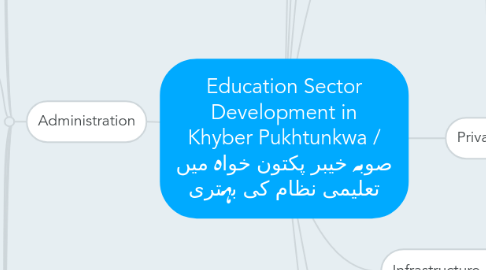
1. Administration
1.1. Finance
1.1.1. Accounts / Directorate Function
1.1.1.1. Audits
1.1.1.1.1. Internal Audit
1.1.1.1.2. External Audit
1.1.1.1.3. Audit of Foreign Aid Projects
1.1.1.2. GP and Pension Fund
1.1.1.3. Reconciliation of Accounts and Reports
1.1.1.4. Procurement and Purchases
1.2. Annual Development Plan
1.2.1. Budgets / Directorate Function
1.2.1.1. Provincial Budget
1.2.1.2. District Buget
1.2.1.2.1. Monitoring of Budget Expenditure
1.2.1.2.2. PTC Funds
1.2.1.3. Central Budget
1.2.2. Mid Term Development Plan
1.2.3. Concept Papers and Feasibility Plans for Projects, PC III.
1.2.4. Evaluation Report / Competing Reports of Projects PC iV PC V.
1.2.5. Evidence of Use of Decision Support System
1.2.6. Database of ADB
1.2.6.1. Detail of Allocation
1.3. Human Resources in Education Department
1.3.1. Trainig
1.3.1.1. Directorate of Curriculum and Teachers Education
1.3.1.1.1. curriculum and learning material
1.3.1.1.2. Supplementary teaching Support Material
1.3.1.1.3. Management of pre-service teacher training in Khyber Pakhtunkhwa.
1.3.1.1.4. Management of In-service trainings for elementary and secondary school teachers
1.3.1.1.5. Assessment and evaluation of education system.
1.3.1.1.6. Development of quality teacher trainings material.
1.3.1.1.7. Preparation of need-based in-service training packages.
1.3.1.2. Provincial Institue of Teachers Education (PITE)
1.3.1.2.1. List of Training Modules
1.3.1.2.2. Training Reports
1.3.1.2.3. Post Training Implementation Reports
1.3.1.2.4. Research Studies
1.3.1.3. Mentoring Program for Teachers
1.3.1.4. Provincial Institue of Teachers Education (PITE
1.3.2. Teachers
1.3.2.1. Hiring of Teachers
1.3.2.1.1. Hiring Process
1.3.2.1.2. Hiring Plan
1.3.2.2. Posting & Transfer of Teachers
1.3.2.2.1. Transfer Policy
1.3.2.3. Training of Teachers
1.3.2.3.1. Teacher Training Institutes Public
1.3.2.3.2. Teachers Training Institute Private
1.3.2.4. Vacant Posts
1.3.2.4.1. Reports
1.3.3. Job Description of Positions
1.3.3.1. Secretariat
1.3.3.2. Directorate
1.3.3.3. District Level
1.3.3.4. Directorate of Curriculum and Teachers Training
1.3.3.5. Provincial Institute of Teacher Education
1.3.3.5.1. Reports
1.3.3.5.2. Standard Operating Procedures
1.3.3.6. Training of Administrative Staff
1.3.3.6.1. Training on Standard Operating Procedures
1.3.4. Personnel Database HRMIS / Directorate Function
1.3.4.1. Statistics
1.3.4.2. Reports
1.3.4.3. Deployment of Staff in Organizational Units
1.3.4.4. Pending S&E Approvals
1.3.5. Promotion of Staff
1.3.5.1. Promotion List
1.3.5.2. 4 tier policy
1.4. Act / Ordinance / Laws and Procedures
1.4.1. Reform Program
1.4.1.1. Education Sector Reform Unit
1.4.1.1.1. Examination Boards Reforms
1.4.1.1.2. PTC Reforms
1.4.1.1.3. Teacher Training Institutes
1.4.1.1.4. Capacity Building Plan
1.4.1.1.5. Progress on Reforms
1.4.1.1.6. Public Private Partnership Policy
1.4.1.1.7. Learning Achievement
1.4.1.1.8. Conducting of monthly progress review meeting with EDOs.
1.4.2. Reforms in Parent Teachers Council
1.4.3. Governing Bodies in Higher Secondary Schools
1.4.3.1. Policy & Decision Making in Boards
1.4.3.2. Reforms by Governing Boards
1.4.3.3. Rules and Procedures for Governing Boards
1.4.4. Education Code 1935
1.5. Donor Engagement
1.5.1. Donor financial contribution and allocation
1.5.2. List of Donor Projects
1.5.2.1. Project Proposals / Logframes
1.5.2.2. Progress Reports on Donor Projects
1.5.3. MOU's and Cooperation Frameworks
1.6. Annual Confidential Reviews / Performance Evaluation
1.7. Administration of Scholarships
1.8. Management Information System
1.8.1. GIS
1.8.1.1. Data Management Standards
1.8.2. EMIS
1.8.2.1. Data Management Standards
1.8.2.1.1. Information Audit
1.8.2.1.2. Quality Standards
1.8.2.1.3. Backup and Security
1.8.2.2. Reports and Aggregate Statistics for Different Levels
1.8.2.3. Census Data and Reports
1.8.2.4. Evidence Based Planning
1.8.2.5. Real Time Systems / Data Entry Delays
1.8.3. Complaint Management System
1.8.4. Performance Management System
1.8.4.1. Service Delivery Standards
1.8.4.1.1. Ranking of Administrative Circles
1.8.4.1.2. Communication with Admin Circles
1.8.4.2. Reward and Penalties
1.8.5. Project Management System
1.8.5.1. Project Tracking
1.8.5.2. Routine Performance Reports by Districts
1.8.5.3. Inspection Reports
1.8.5.4. Monitoring Systems
1.8.5.4.1. Process Audits As Per the Rules of Business
1.8.6. IT Software and Hardware Deployed
1.8.7. IT Strategy / Framework
1.8.8. Operation Manuals
1.8.9. Documentation of IT Systems
1.8.10. Planning Management Information System
1.8.11. HRMIS Human Resource Management Information System
1.8.11.1. Seniority List
1.8.12. Education through communication and Information Technology (CIT).
1.8.13. Teacher Training Management Information System (TTMIS)
1.8.14. Financial Management Information System (FMIS)
1.8.15. Workflow Management Based on Rules of Business
1.9. Communications
1.9.1. Contacts
1.9.2. Multimedia Content on Official Website
1.9.2.1. Recordings of Any Video Conferences
1.9.2.2. Videos to Explain Policies or Procedures in Department
1.9.2.2.1. 4 Tier Formula in Department
1.9.2.2.2. Education Census Forms
1.9.2.2.3. Manual of Secretariat Instructions
1.9.3. Updating of Website / Reports
1.9.4. Communication and Dissemination Strategy
1.9.5. Internet Facility and Emails at District Level
1.9.6. Website Standards for Affiliated Institutions / BISE
1.10. Special Initiatives
1.10.1. Tameer i School Program
1.10.2. Model Schools & Cadet Colleges
1.10.2.1. List of Schools
1.10.2.2. Funding Provided
1.10.3. Emergency Education
1.10.3.1. Militancy
1.10.3.2. Floods
1.10.4. Thumb Print Attendance System
1.10.5. Special Incentive for Teachers
1.10.6. Arranging science & arts exhibition
1.10.6.1. List of Events in the Past
1.10.6.2. Previous Reports
1.10.6.3. Proposed Programs for the future
2. Partnership and Institutional Partnerships
3. Infrastructure
3.1. Missing facilities
3.2. Construction Progress
3.3. Resources Required
3.4. PC-1 to PC V for Projects
3.5. Upgrading of Schools
3.6. Maintenance of Schools
3.7. Inspection Reports of Under Constructed Schools
4. Students
4.1. Enrollment
4.1.1. Preschool Children Registration
4.1.2. Drop out rates
4.1.3. Repetition rates
4.2. Attendance Dropouts
4.3. Assessment
4.3.1. BISE Established in KP
4.3.1.1. Reforms in BISE
4.3.1.1.1. Examination System Reforms in KP
4.3.1.1.2. Administrative Reforms in BISE
4.3.1.2. Progress on Reforms n BISE
4.3.2. Examination Results and Learning Achievements
